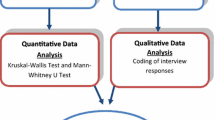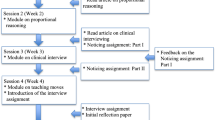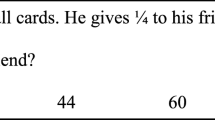Abstract
This paper highlights the second phase of a multi-university research project focusing on improving secondary prospective mathematics teachers’ abilities to respond to student thinking. This work is based on an Interview Module, created by the authors, which showed gains in prospective teachers’ (PSTs) abilities to attend to and interpret student thinking but did not show the same gains in their abilities to respond to student thinking. The Interview Module originally included a pre–post-video, readings, discussion, and one-on-one interview with a secondary student (Lesseig et al. in Math Teach Educ 5(1):29–46, 2016). This second phase adds a take-home assignment based on solutions from the secondary students who were interviewed in Phase 1. This take-home assignment was designed to specifically improve PSTs’ abilities to respond to student thinking. Results indicate that gains were made in their ability to respond, as was intended, but, unexpectedly, greater gains were also found in their abilities to attend to and interpret student thinking compared with Phase 1.




Similar content being viewed by others
References
Anthony, G., Hunter, J., & Hunter, R. (2015). Supporting prospective teachers to notice Students’ mathematical thinking through rehearsal activities. Mathematics Teacher Education and Development,17(2), 7–24.
Ball, D. L. (2011). Foreward. In M. Sherin, V. Jacobs, & R. Philipp (Eds.), Mathematics teacher noticing: Seeing through teachers’ eyes. New York, NY: Routledge.
Ball, D. L., & Cohen, D. K. (1999). Developing practice, developing practitioners: Toward a practice-based theory of professional education. In G. Sykes & L. Darling-Hammond (Eds.), Teaching as the learning profession: Handbook of policy and practice. San Francisco: Jossey Bass.
Ball, D. L., & Forzani, F. M. (2009). The work of teaching and the challenge for teacher education. Journal of Teacher Education,60(5), 497–511.
Brown, J. S., Collins, A., & Duguid, P. (1989). Situated cognition and the culture of learning. Educational Researcher,18(1), 32–42.
Carpenter, T. P., Fennema, E., Franke, M. L., Levi, L., & Empson, S. B. (1999). Children’s mathematics: Cognitively guided instruction. Portsmouth, NH: Heinemann.
Cazden, C. B., & Beck, S. W. (2003). Classroom discourse. In A. C. Graesser, M. A. Gernsbacher, & S. Goldman (Eds.), Handbook of discourse processes (pp. 165–197). Mahwah, NJ: Lawrence Erlbaum Associates.
Crespo, S. (2002). Praising and correcting: Prospective teachers investigate their teacherly talk. Teaching and Teacher Education,18(6), 739–758.
Denzin, N. K., & Lincoln, Y. S. (2011). The Sage handbook of qualitative research. Thousand Oaks: Sage.
Ding, L., & Domínguez, H. (2016). Opportunities to notice: Chinese prospective teachers noticing students’ ideas in a distance formula lesson. Journal of Mathematics Teacher Education,19(4), 325–347.
Edwards, D., & Mercer, N. (1987). Common knowledge: The development of understanding in the classroom. London: Routledge.
Franke, M. L., Kazemi, E., & Battey, D. (2007). Mathematics teaching and classroom practice. In F. K. Lester Jr. (Ed.), Second handbook of research on mathematics teaching and learning (pp. 225–256). Charlotte, NC: Information Age Publishing.
Franke, M. L., Webb, N. M., Chan, A. G., Ing, M., Freund, D., & Battey, D. (2009). Teacher questioning to elicit students’ mathematical thinking in elementary school classrooms. Journal of Teacher Education,60(4), 380–392.
Goodwin, C. (1994). Professional Vision. American Anthropologist, 96(3), 606–633.
Herbal-Eisenmann, B. A., & Breyfogle, M. L. (2005). Questioning our patterns of questioning. Mathematics Teaching in the Middle School,10(9), 484–489.
Huntley, M. A., Marcus, R., Kahan, J., & Miller, J. L. (2007). Investigating high-school students’ reasoning strategies when they solve linear equations. The Journal of Mathematical Behavior,26(2), 115–139.
Jacobs, V. R., & Ambrose, R. C. (2008). Making the most of story problems. Teaching Children Mathematics,15(5), 260–266.
Jacobs, V. R., Lamb, L. L., & Philipp, R. A. (2010). Professional noticing of children’s mathematical thinking. Journal for Research in Mathematics Education,41, 169–202.
Jacobs, V. R., Lamb, L. L., Philipp, R. A., & Schappelle, B. P. (2011). Deciding how to respond on the basis of children’s understanding. In M. Sherin, V. Jacobs, & R. Philipp (Eds.), Mathematics teacher noticing: Seeing through teachers’ eyes (pp. 97–116). New York: Routledge.
Kazemi, E., Ghousseini, H., Cunard, A., & Turrou, A. C. (2015). Getting inside rehearsals insights from teacher educators to support work on complex practice. Journal of Teacher Education,67(1), 18–31.
Krupa, E. E., Huey, M., Lesseig, K., Casey, S., & Monson, D. (2017). Investigating secondary prospective teachers’ noticing of student thinking. In E. O. Schack, J. Wilhelm, & M. H. Fisher (Eds.), Teacher noticing: Bridging and broadening perspectives, contexts, and frameworks research in mathematics education (Vol. 6, pp. 49–72). Berlin: Springer.
Lampert, M., Franke, M. L., Kazemi, E., Ghousseini, H., Turrou, A. C., Beasley, H., et al. (2013). Keeping it complex using rehearsals to support novice teacher learning of ambitious teaching. Journal of Teacher Education,64(3), 226–243.
Lesseig, K., Casey, S., Monson, D., Krupa, E. E., & Huey, M. (2016). Developing secondary PST’s ability to notice and elicit student thinking: A task-based interview assignment. Mathematics Teacher Educator, 5(1), 29–46.
Mason, J. (2002). Researching your own practice: The discipline of noticing. London: RoutledgeFalmer.
Mason, J. (2011). Noticing: roots and branches. In M. G. Sherin, V. R. Jacobs, & R. A. Philipp (Eds.), Mathematics Teacher Noticing: Seeing Through Teachers’ Eyes. Studies in Mathematical Thinking and Learning (pp. 35–50). New York: Routledge.
McDonald, M., Kazemi, E., & Kavanagh, S. S. (2013). Core practices and pedagogies of teacher education a call for a common language and collective activity. Journal of Teacher Education,64(5), 378–386.
McDuffie, A. R., Foote, M. Q., Bolson, C., Turner, E. E., Aguirre, J. M., Bartell, T. G., et al. (2014). Using video analysis to support prospective K-8 teachers’ noticing of students’ multiple mathematical knowledge bases. Journal of Mathematics Teacher Education,17(3), 245–270.
Miles, M. B., Huberman, A. M., & Saldana, J. (2013). Qualitative data analysis: A methods sourcebook. Thousand Oaks: SAGE Publications.
Milewski, A., & Strickland, S. (2016). (Toward) Developing a common language for describing instructional practices of responding: A teacher-generated framework. Mathematics Teacher Educator,4(2), 126–144.
Mitchell, R. N., & Marin, K. A. (2015). Examining the use of a structured analysis framework to support prospective teacher noticing. Journal of Mathematics Teacher Education, 18(6), 551–575.
Molinari, L., & Mameli, C. (2013). Process quality of classroom discourse: Pupil participation and learning opportunities. International Journal of Educational Research,62, 249–258.
National Council of Teachers of Mathematics. (2014). Principles to actions: Ensuring mathematics success for all. Reston, VA: National Council of Teachers of Mathematics.
National Research Council. (2001). Adding it up: Helping children learn mathematics. In J. Kilpatrick, J. Swafford, & B. Findell (Eds.), Mathematics Learning Study Committee, Center for Education, Division of Behavioral and Social Sciences and Education. Washington, DC: National Academy Press.
Putnam, R. T., & Borko, H. (2000). What do new views of knowledge and thinking have to say about research on teacher learning? Educational Researcher,29(1), 4–15.
Rowland, T., & Zazkis, R. (2013). Contingency in the mathematics classroom: Opportunities taken and opportunities missed. Canadian Journal of Science, Mathematics and Technology Education,13(2), 137–153.
Santagata, R., & Angelici, G. (2010). Studying the impact of the lesson analysis framework on prospective teachers’ abilities to reflect on videos of classroom teaching. Journal of Teacher Education,61, 339–349.
Schack, E. O., Fisher, M. H., Thomas, J. N., Eisenhardt, S., Tassell, J., & Yoder, M. (2013). Prospective elementary school teachers’ professional noticing of children’s early numeracy. Journal of Mathematics Teacher Education,16(5), 379–397.
Schack, E. O., Fisher, M. H., & Wilhelm, J. A. (Eds.). (2017). Teacher noticing: Bridging and broadening perspectives, contexts, and frameworks. Berlin: Springer.
Schön, D. A. (1983). The reflective practitioner: How professionals think in action. New York: Basic Books.
Sherin, B., Sherin, M., Colestock, A. A., Russ, R., Luna, M., Mulligan, M., Walkoe, J., & Hall, R. (2010). Using digital video to investigate teachers' in-the-moment noticing. In Learning in the Disciplines: ICLS 2010 Conference Proceedings - 9th International Conference of the Learning Sciences (Vol. 2, pp. 179–186).
Sherin, M., Jacobs, V., & Philipp, R. (Eds.). (2011). Mathematics teacher noticing: Seeing through teachers’ eyes. New York, NY: Routledge.
Sherin, M. G., & van Es, E. A. (2009). Effects of video club participation on teachers’ professional vision. Journal of Teacher Education,60(1), 20–37.
Simpson, A., & Haltiwanger, L. (2017). “This is the first time I've done this”: Exploring secondary prospective mathematics teachers’ noticing of students’ mathematical thinking. Journal of Mathematics Teacher Education, 20(4), 335–355.
Sleep, L. (2012). The work of steering instruction toward the mathematical point a decomposition of teaching practice. American Educational Research Journal,49(5), 935–970.
Son, J. W. (2013). How prospective teachers interpret and respond to student errors: Ratio and proportion in similar rectangles. Educational Studies in Mathematics,84(1), 49–70.
Son, J. W., & Crespo, S. (2009). Prospective teachers’ reasoning and response to a student’s non-traditional strategy when dividing fractions. Journal of Mathematics Teacher Education,12(4), 235–261.
Son, J. W., & Sinclair, N. (2010). How prospective teachers interpret and respond to student geometric errors. School Science and Mathematics,110(1), 31–46.
Weiss, I. R., Pasley, J. D., Smith, P. S., Banilower, E. R., & Heck, D. J. (2003). Looking inside the classroom. Chapel Hill, NC: Horizon Research Inc.
Author information
Authors and Affiliations
Corresponding author
Rights and permissions
About this article
Cite this article
Monson, D., Krupa, E., Lesseig, K. et al. Developing secondary prospective teachers’ ability to respond to student work. J Math Teacher Educ 23, 209–232 (2020). https://doi.org/10.1007/s10857-018-9420-8
Published:
Issue Date:
DOI: https://doi.org/10.1007/s10857-018-9420-8




